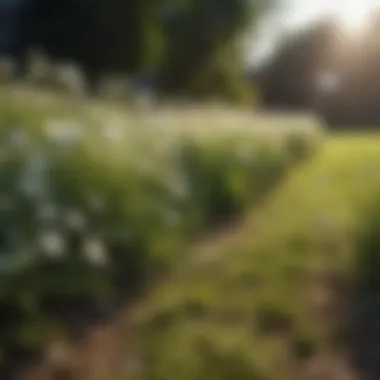Identifying and Managing Lawn Weeds with White Flowers


Intro
Lawn weeds with white flowers can be a significant challenge for both amateur gardeners and seasoned horticulturists. These plants are often perceived as nuisances that spoil the aesthetics of well-maintained lawns. However, understanding their role within the ecosystem is crucial. Not only do these weeds compete for vital resources, but they can also provide insights into the condition of the soil.
The presence of certain white-flowered weeds can signal issues such as poor drainage or nutrient deficiencies. Addressing these issues leads to a healthier lawn and supports overall ecological balance. This article provides detailed insights into these weeds, their identification, ecological contributions, and management techniques.
Current Trends in Agriculture and Horticulture
Overview of Recent Innovations
In recent years, there has been a marked shift towards integrative pest management (IPM) strategies. This approach aims to minimize chemical usage, focusing instead on understanding the natural cycles of ecosystems. Among eleven key themes discussed in this domain, the management of weeds with white flowers has received attention.
Sustainable Practices Gaining Popularity
Gardeners are increasingly adopting sustainable practices. The use of compost to enhance soil health and introduce beneficial microbes is now common. Additionally, mulching can suppress the growth of unwanted weeds while maintaining soil moisture. These organic practices are beneficial for managing white-flowered weeds and promoting overall lawn health.
Understanding Common White Flowered Weeds
Identification of Common Species
Some well-known white flowering weeds include:
- Chickweed (Stellaria media): A delicate plant with small white flowers, commonly found in moist, nutrient-rich soils.
- Clover (Trifolium spp.): Especially white clover, this plant is a low-growing perennial that can enhance nitrogen levels in the soil.
- Daisy (Bellis perennis): A familiar lawn presence, daisies are resilient and can thrive in a variety of conditions.
The identification of these species is essential for effective management. Understanding their growth patterns, blooming seasons, and soil preferences informs the appropriate interventions.
Ecological Impact
White flowered weeds can have both positive and negative effects on lawns. On one hand, they compete for resources like water and nutrients, potentially stunting the growth of ornamental grasses. On the other hand, some species, like clover, can provide benefits. They fix nitrogen, improving soil fertility.
Understanding the dual role of weeds is essential for sustainable lawn maintenance.
Effective Management Practices
To mitigate the effects of white flowering weeds while promoting beneficial species, consider the following management techniques:
- Regularly mow the lawn to prevent weeds from flowering and going to seed.
- Implement crop rotation in garden areas, increasing biodiversity and reducing weed proliferation.
- Apply targeted organic herbicides or hand-pulling in smaller areas as needed.
These practices can enhance lawn quality while minimizing chemical input.
Epilogue
In summary, the understanding and management of lawn weeds with white flowers involve awareness of their ecological roles and characteristics. By adopting sustainable practices and targeted techniques, gardeners not only tackle the issue of aesthetically displeasing weeds, but also contribute to a healthier environment.
Prelude to Lawn Weeds
Lawn weeds are more than just unsightly intruders; they play complex roles in garden ecosystems. Their presence can signify various things about soil health and lawn management practices. This article focuses on white-flowering weeds that can take over lawns, sometimes without notice. Understanding these weeds' characteristics and impacts is crucial for anyone interested in lawn care.
In this section, we will explain what weeds are and their ecological roles. Both definitions and functions will guide readers towards better lawn management strategies. By recognizing the traits of weeds, especially those with white flowers, gardeners can make more informed decisions on maintaining their landscapes.
Defining Weeds
Weeds are plants that are considered undesirable in a particular setting. They can outcompete desirable plants for resources like water, nutrients, and sunlight. The definition varies depending on context. A species labeled as a weed in a garden may be appreciated in a wildflower field. Generally, they are opportunistic plants. Their growth often indicates disturbances in the natural ecosystem or lawn care practices.
By knowing how to define weeds, gardeners can begin identifying specific types that may invade their lawns. They also learn about the effects of these weeds on overall garden health, which makes dealing with them easier.
The Role of Weeds in Ecosystems
Weeds serve roles in ecosystems, sometimes overlooked. While they may compete with desired plants, they also help in other ways:
- Soil Stabilization: Weeds can prevent erosion. Their roots bind the soil, holding it in place.
- Nutrient Cycling: Weeds, when decomposed, add organic matter to the soil, enriching it further.
- Biodiversity Promotion: Many weeds attract pollinators. They can support a range of insects that assist in plant reproduction.
"Weeds contribute to the functioning of ecosystems, playing roles that many gardeners often neglect."


Understanding these contributions can foster a better approach to lawn management. Rather than an adversarial relationship with weeds, gardeners can view them as part of a broader ecological picture. In future sections, we will explore specific weeds with white flowers, their impacts, and strategies to manage them effectively.
Characteristics of Weeds with White Flowers
When assessing lawn health and aesthetics, understanding the characteristics of weeds with white flowers is crucial. These weeds can inform landowners about soil conditions and overall ecosystem health. White flowering weeds often display specific traits that set them apart from desirable plants. Knowing these traits can aid in identification and management, allowing for more effective lawn care.
Identifying Common Traits
White flowering weeds typically share certain features that make them identifiable. First, the flower structure is distinct; many possess clusters of small white blooms. For example, clover has rounded flower heads filled with tiny flowers, while chickweed produces star-like patterns with delicate petals.
Their leaf arrangements also differ. Many white flowering weeds have broad leaves that may be smooth or serrated, which can be essential in identification. For instance, plantain has large, oval leaves growing close to the ground, while common bindweed features arrow-shaped leaves.
The growth habit is another key element. These weeds tend to be hardy and aggressive, often growing in patches. Observing how they spread can provide insight into their management. Some may root deeply, while others spread through seeds or runners. Recognizing these traits helps in distinguishing them from cultivated grasses.
Ecological Significance
The presence of white flowering weeds in a lawn carries ecological implications. They can indicate soil health, revealing nutrient deficiencies or excesses. For instance, a lawn dominated by clover may suggest nitrogen-poor soil. Clover is known for its nitrogen-fixing capabilities, which can enhance the surrounding soil.
These weeds can also support biodiversity. They attract various pollinators, including bees, which are vital for pollinating many crops and plants. Increased biodiversity can enhance the resilience of local ecosystems. However, it's important to balance this positive impact with the potential competition these weeds pose to ornamental grasses. Monitoring their growth and impacts ensures a healthier lawn environment.
"Understanding the characteristics of weeds with white flowers empowers landowners to make informed management decisions, ultimately leading to thriving landscapes."
In summary, identifying common traits and recognizing the ecological significance of white flowering weeds contribute to effective lawn care strategies. The insights gained from these characteristics can inform both immediate management actions as well as long-term sustainability practices.
Common Lawn Weeds with White Flowers
In the realm of lawn care, understanding common weeds with white flowers is crucial. These plants may seem innocuous at a glance, but they have distinct traits and can impact the health of the lawn. Identifying these weeds can help in maintaining lawn aesthetics and ensuring the health of desirable grass species.
White flowering weeds often signify certain conditions in the soil. Recognizing their presence can also guide gardeners toward long-term management strategies. For many, the sight of these flowers can be viewed as beauty, while for others, they represent a challenge. Their management requires a deeper comprehension to strike a balance between achieving a pristine lawn and fostering environmental health.
Clover
Types of Clover
Clover, with its characteristic tri-leaf structure and white flowers, presents various types. The most common include white clover and red clover. Leguminous plants, they are known for fixing nitrogen in the soil, which is a significant benefit for the ecosystem. This feature reduces the need for chemical fertilizers and promotes healthier soil.
Furthermore, clover serves as a significant forage crop for local wildlife, particularly bees, enhancing biodiversity in the area. While managing clover may sound negative due to its weed classification, its presence often indicates rich, fertile soil.
Growth Patterns
The growth patterns of clover are also noteworthy. Typically, clover spreads through both seeds and vegetative means. This resilience makes it an effective ground cover, choking out less desirable weeds. However, its aggressive nature can be a downside, as it may quickly take over areas intended for more delicate plants. Understanding these growth patterns helps in deciding whether to promote or control clover in specific areas of the lawn.
Plantain
Identification Features
Plantain is another common weed with white flowering characteristics. This plant can be easily identified by its broad leaves and stalks that rise above the foliage, topped with white flower spikes. These distinct features allow gardeners to recognize plantain quickly, making management more efficient. Its structural toughness enables it to thrive in compacted soils, often standing out where other plants may fail to grow.
Ecological Function
The ecological function of plantain is significant. It offers benefits like soil stabilization and erosion control. Additionally, its extensive root system aids in breaking up compacted soil, enhancing water infiltration. This can improve overall soil health, making it a worthwhile consideration in lawn care discussions. However, its aggressive growth can also lead to an overrun of desired species, which could warrant control measures.
Chickweed
Characteristics
Chickweed commonly appears in lawns, identified by its small white flowers and succulent leaves. This plant prefers cooler weather and can often be found spreading across lawns in early spring. Its growth habit can lead to dense mats that might suppress the growth of desired grasses. While not harmful, it does require vigilance as it can establish quickly. Understanding this characteristic aids in making informed management decisions about which plants to encourage or remove.
Habitat Preferences
Chickweed shows a preference for moist, fertile soils and partial shade. This means it can thrive in areas where other plants struggle, especially under trees or shrubs. The ability to adapt to various habitats emphasizes the need for landscape planning, ensuring desirable plants receive adequate light and moisture. Understanding these habitat preferences can guide lawn maintenance practices for optimal growth of desirable species.
Common Bindweed


Growth Characteristics
Common bindweed is often recognized by its twining, vine-like growth. Its white flowers can be deceiving, as they may appear attractive but indicate an invasive tendency. Bindweed grows quickly, often overwhelming other plants in its surrounding area. This fast growth can be advantageous in covering weak spots but often results in competition with desired plants for nutrients and sunlight.
Control Measures
Effective control measures for common bindweed require a proactive approach. Mechanical removal methods, such as pulling up plants, can be beneficial, but complete eradication often requires integrating herbicidal treatments. Timing these measures is essential to success, as bindweed can regrow from fragments left in the soil. Understanding the best practices for control is key to managing this particular weed without harming other value plants.
Oxalis
Recognition Tips
Recognizing oxalis is simple due to its distinctive shamrock-like leaves and clusters of small white flowers. This perennial plant can be both a garden weed and a charming addition, depending on the context of its growth. Its ability to thrive in various environments allows it to establish quickly, making it essential for gardeners to identify it swiftly to avert unchecked growth.
Environmental Considerations
Oxalis can serve as an indicator of specific soil conditions, particularly acidic and moist environments. While it may provide some ground cover, its invasiveness can hinder the growth of more valued plants. Thus, understanding its environmental considerations aids in balancing its presence and determining if it should be managed or cultivated, based on the aesthetic or ecological goals of the lawn.
Impacts of White Flowering Weeds on Lawns
The presence of white flowering weeds can significantly influence lawn ecosystems. Understanding these impacts is crucial for gardeners and lawn enthusiasts aiming for healthy, flourishing green spaces. White flowering weeds not only compete for resources but also serve as indicators of soil conditions and overall biodiversity.
Nutrient Competition
White flowering weeds like clover or chickweed are notorious for their ability to absorb nutrients from the soil. They often compete directly with desired grass species. While some may perceive this competition negatively, it also highlights important ecological dynamics.
These weeds can deplete essential nutrients such as nitrogen, phosphorus, and potassium. This depletion can lead to a decline in the health of the lawn. Conversely, certain white flowering weeds can fix nitrogen in the soil, improving fertility over time. Understanding this balance is vital. Lawn caretakers may want to monitor the types of weeds present. If beneficial species are dominant, they may choose to maintain them instead of removing everything.
Soil Health Indicators
White flowering weeds can serve as important indicators of soil health. Their presence often signifies underlying issues, such as compaction or poor nutrient availability. For instance, a lawn heavily infested with plantain might suggest soil compaction, as this weed thrives in such conditions.
"Observing weed species can provide insights into lawn health that are not otherwise visible."
Assessing the types of white flowering weeds present can guide management practices. By addressing soil health, such as improving aeration or adjusting nutrient input, lawn enthusiasts can create a more favorable environment for desirable plants.
Biodiversity Effects
The role of white flowering weeds extends beyond mere competition. They contribute to increased biodiversity in lawns. This biodiversity can support various beneficial insects, pollinators, and other wildlife. White flowering species like clover attract bees, which are essential for pollination.
Furthermore, a diverse ecosystem is generally more resilient. A lawn that incorporates a variety of plant species can better withstand pests and diseases. Therefore, allowing certain white flowering weeds could enhance the overall ecosystem health of the lawn.
In summary, the impacts of white flowering weeds on lawns are multifaceted. They pose challenges through nutrient competition but also offer benefits as soil health indicators and biodiversity enhancers. Lawn managers should consider these factors in their maintenance strategies. By understanding and managing these weeds smartly, one can create a balanced approach to lawn care.
Management Strategies for White Flowering Weeds
Managing weeds with white flowers involves a blend of techniques aimed at keeping lawns healthy and aesthetically pleasing. Understanding these strategies is essential for maintaining balance in landscaping. This section will focus on cultural practices, mechanical methods, and chemical options to control these weeds effectively.
Cultural Practices
Mowing Techniques
Mowing is crucial for lawn management. Regular mowing prevents weeds from flowering and producing seeds. This ultimately reduces their spread. Keeping the mower blade sharp is important. Also, mowing at the right height promotes grass health. Grass that is too short can stress and invites weeds.
Another key characteristic of proper mowing is the timing. Avoid mowing wet grass to prevent damage and soil compaction. This approach is sustainable, reducing the reliance on chemical treatments. However, if neglected, weeds can become resistant.
Fertilization Practices
Fertilizing the lawn supports healthy grass, making it harder for weeds to thrive. A well-nourished lawn can better compete with invasive species. The key characteristic of effective fertilization is soil testing. Knowing the nutrient needs of the grass informs fertilization schedules.
Organic options, such as compost, enhance soil health over time. They improve water retention and nutrient availability. However, over-fertilization can promote weed growth, which makes it critical to monitor amounts regularly.
Mechanical Control Methods


Hand Weeding
Hand weeding is a basic yet effective method of controlling white flowering weeds. This involves physically removing the weeds from the ground. The most significant advantage is precise removal, including roots. This minimizes the chance of regrowth.
However, it is labor-intensive, especially in large areas. It also requires persistence, as missed roots can lead to the weed's return. Nevertheless, it is an eco-friendly option that avoids chemicals.
Use of Tools
Mechanical tools like hoe or trowel aid in weed management. These tools allow for faster removal of weeds than hand weeding alone. The advantages include efficiency and effectiveness. Tools can cover larger areas in less time.
Yet, improper use might damage surrounding grass. Regular maintenance of tools helps them work better. Choosing the right tool for the right weed is important for success.
Chemical Control Options
Herbicide Types
Herbicides are chemical solutions specifically designed to control weeds. They can be selective or non-selective. Selective herbicides target specific weed types, preserving desirable vegetation. This makes them a popular choice for white flowering weeds.
While effective, reliance on herbicides raises concerns. Potential for resistance develops when used improperly. Moreover, they can harm beneficial insects and soil health if not applied carefully.
Application Guidelines
Proper application guidelines are key to effective herbicide use. This includes following the label instructions carefully. Timing of application, like during active growth, increases effectiveness.
However, weather conditions such as wind can affect application. Avoid applying before rain, which can wash away product. Educating oneself on local regulations concerning herbicide use is also important. Always aim for a balanced approach to weed management that does not rely solely on chemicals.
Managing white flowering weeds involves using various combined strategies. These practices enhance lawn health while keeping ecological balance.
Integrating Weeds into Lawn Management Plans
Understanding how to incorporate weeds, specifically those with white flowers, into a lawn management strategy is essential for sustainable gardening. Weeds often get a bad reputation, but they can offer insights into your lawn’s ecosystem. Integrating weeds into your management plan means recognizing their role and finding a balance that promotes lawn health while controlling unwanted growth.
One key aspect of this integration is assessing lawn health. By observing the types of weeds present, one can glean information about soil conditions, moisture levels, and nutrient availability. For example, a predominance of clover might indicate nitrogen-deficient soil, which could be improved with appropriate amendments.
Additionally, weeds can sometimes serve as indicators of optimal moisture levels in your lawn. If certain weeds flourish, it might indicate that the area holds enough moisture or contains compaction issues. By understanding what these weeds signify, lawn care enthusiasts can develop a more informed strategy regarding soil management.
"Weeds as a diagnostic tool can redirect your management approach effectively."
Assessing Lawn Health
To assess lawn health accurately, one must examine conditions contributing to weed proliferation. Observations should include:
- Soil Quality: Test for pH and nutrient content. Poor soil quality can lead to higher weed growth, as they often thrive in neglected conditions.
- Moisture Levels: Noticing areas of excess moisture or dryness informs necessary irrigation adjustments.
- Grass Type: Position grass varieties that are more competitive against weeds.
A comprehensive approach will allow you to identify problem areas quickly. This proactive assessment is essential for maintaining overall lawn vitality.
Weed Tolerance Approaches
Embracing a weed tolerance strategy involves allowing certain weeds to coexist with desired plants while finding ways to limit their impact. This practice encourages biodiversity and can lead to a healthier lawn ecosystem. Several approaches include:
- Selective Allowance: Some weeds have beneficial properties, like clover, which can fix nitrogen in the soil. Allowing them in moderation can be advantageous.
- Adaptive Mowing Techniques: Adjust mowing heights to favor grass growth over weed species, promoting a healthier lawn without total eradication of all weeds.
- Encouraging Native Plants: Introducing native plant species can help control weeds naturally, as they often compete for the same resources.
This integrated approach can lead to a more robust ecosystem, reducing reliance on synthetic herbicides and promoting sustainable practices within lawn care. By thoughtfully managing white flowering weeds, lawn care can become a less arduous task while still achieving aesthetic goals.
Culmination: Towards Sustainable Lawn Care
The discussion on lawn weeds with white flowers culminates in understanding their role within sustainable lawn care practices. These weeds, often dismissed as mere nuisances, can offer insights into ecosystem health and soil conditions. This conclusion emphasizes the need for a strategic approach to lawn management that balances aesthetic desires with ecological responsibility.
Implementing sustainable practices in lawn care is essential. Integrating weeds into lawn management plans allows for a comprehensive understanding of the lawn ecosystem. Recognizing that weeds can contribute to biodiversity is important. This can lead to more resilient grass ecosystems, which may ultimately reduce the need for chemical interventions.
Summarizing Key Takeaways
- Lawn weeds with white flowers, such as clover and chickweed, serve multiple roles in the ecosystem, including enhancing soil fertility and providing cover.
- Effective lawn care begins with identifying and understanding the weeds present in your lawn. This identification enables more informed management strategies.
- Sustainable practices can minimize chemical use, promoting healthier habitats and encouraging beneficial insects and native plants.
- Awareness of the ecological impacts of weeds enhances lawn management decisions, leading to healthier and more sustainable lawns.
Future Considerations
As we look to the future of lawn care, it is crucial to embrace ecological principles. Consider the following aspects:
- Soil Health: Continuous monitoring of soil conditions can guide interventions and adjustments, ensuring desired plant growth.
- Ecosystem Diversity: Encouraging a mix of native plants alongside common lawn grasses can enhance resilience against pests and diseases.
- Education: Raising awareness about the benefits of certain weeds within the community can shift perspectives, promoting practices that favor ecological balance over aesthetic perfection.
The journey towards sustainable lawn care is not merely about weed control. It is about understanding complex interactions within the ecosystem. By fostering such understanding, lawn enthusiasts can effectively manage their spaces while contributing positively to broader environmental goals.



